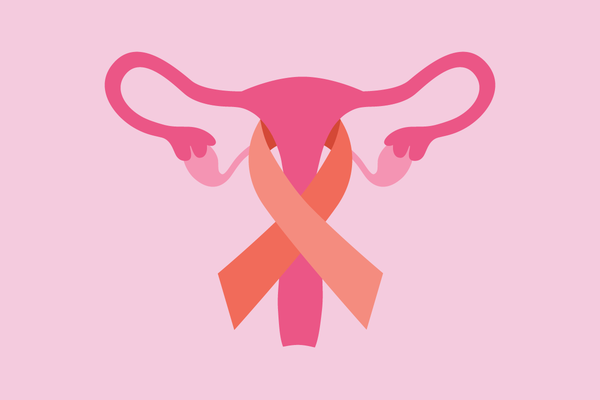Of the types of cancer that affect women’s reproductive systems, endometrial cancer — a type of uterine cancer — is the most common. It’s important to understand the common risk factors for endometrial cancer and how you may be able to lower your risk of getting the disease.
- Endometrial cancer is any cancer that affects the lining of the uterus. The most common type is endometrioid adenocarcinoma, which forms in the glands of the uterus.
- According to the CDC, risk factors for endometrial cancer include, but are not limited to the following:
- Being older than 50
- Being postmenopausal
- Early menstruation (starting your period early)
- Late menopause
- Being overweight or having obesity
- Never having been pregnant, especially if you had trouble getting pregnant
- Having a history of fewer than five periods per year
- Taking estrogen as a standalone hormone replacement drug or taking certain drugs to prevent or treat breast cancer
- Family history of endometrial, colon or ovarian cancer
- Personal history of breast or ovarian cancer
- Genetics, including a condition known as Lynch syndrome, which increases the risk of endometrial, colon and ovarian cancers
- Having Type 2 diabetes
- Having endometrial hyperplasia (thickening of the endometrium)
- Most cases of endometrial cancer occur in postmenopausal women. They are at greater risk of getting endometrial cancer because a hormone imbalance causes more estrogen than progesterone in the body, which can increase the chance of getting the disease.
- In the United States, endometrial cancer is the most common cancer of the female reproductive organs. The average age for diagnosis is 60, and the majority of women are diagnosed between ages 55 and 64.
- White women are slightly more likely to be diagnosed with endometrial cancer than Black women, followed by Hispanic women, Asian/Pacific Islander women and American Indian/Alaskan Native women.
- Black women are nearly twice as likely to die from endometrial cancer than women of any other race because they are generally diagnosed later with more advanced stages of the disease, have surgery less often and may be more likely to have risk factors.
- The most common symptom of endometrial cancer is abnormal menstrual bleeding. This includes any irregular menstrual bleeding, spotting or bleeding between periods. For postmenopausal women, any bleeding is considered abnormal. More-advanced symptoms may include:
- Pain in the lower abdomen or cramps in the pelvis
- Bloating or feeling full quickly when eating
- Changes in bowel or bladder habits
These are not all the possible symptoms of endometrial cancer and may also be indicative of other conditions. Talk to your healthcare provider about any symptoms of concern.
- Endometrial cancer is diagnosed through a pelvic exam, a transvaginal ultrasound, a hysteroscopy, dilation and curettage (D&C), and/or a biopsy.
- Endometrial cancer is often treated first with surgery. Depending on the location and type of cancer, surgery may remove cancerous tissues, the uterus (a hysterectomy), the fallopian tubes and ovaries (a bilateral salpingo-oophorectomy), and/or lymph nodes around the pelvis.
- Other types of treatments may be used after surgery or in place of surgery for younger women who want to keep their fertility or prevent early menopause. This includes radiation therapy, chemotherapy, hormone therapy, targeted therapy and immunotherapy.
- There are no specific screening tests for endometrial cancer. The best thing to do is be aware of the risks and symptoms, and focus on lowering your risk factors.
- Ways you may be able to help lower your risk of getting endometrial cancer:
- Maintain a healthy weight
- Engage in physical activity. Be sure to always check with your healthcare provider before starting a new exercise plan.
- Get annual checkups and report any unusual symptoms — including abnormal menstrual bleeding — to your healthcare provider as soon as possible
- Speak to your healthcare provider for more information about taking progesterone if you take estrogen
References
https://www.ajog.org/article/S0002-9378(16)46212-5/fulltext
https://www.cancer.gov/about-cancer/causes-prevention/risk/obesity/physical-activity-fact-sheet
https://www.cancer.org/cancer/endometrial-cancer/about/key-statistics.html
https://www.cancer.org/cancer/endometrial-cancer/causes-risks-prevention/risk-factors.html
https://www.cancer.org/cancer/endometrial-cancer/detection-diagnosis-staging/signs-and-symptoms.html
https://www.cancer.org/cancer/endometrial-cancer/treating.html
https://www.cdc.gov/cancer/uterine/basic_info/prevention.htm
https://www.cdc.gov/cancer/uterine/basic_info/screening.htm
https://www.cdc.gov/cancer/gynecologic/basic_info
https://www.hopkinsmedicine.org/health/conditions-and-diseases/endometrial-cancer
https://www.hopkinsmedicine.org/health/treatment-tests-and-therapies/dilation-and-curettage-d-and-c
https://www.mayoclinic.org/diseases-conditions/endometrial-cancer/diagnosis-treatment/drc-20352466
https://www.mayoclinic.org/diseases-conditions/endometrial-cancer/symptoms-causes/syc-20352461
https://www.mskcc.org/cancer-care/types/uterine-endometrial
https://www.pennmedicine.org/cancer/types-of-cancer/uterine-cancer-and-endometrial-cancer
https://pubmed.ncbi.nlm.nih.gov/19078930
https://seer.cancer.gov/statfacts/html/corp.html
This resource was created with funding and support from Eisai Inc.
- Living with Endometrial Cancer ›
- How Endometrial Cancer Is Diagnosed - HealthyWomen ›
- Is It Endometriosis or Endometrial Cancer? - HealthyWomen ›
- Ask the Expert: Endometrial Cancer - HealthyWomen ›
- My Endometrial Cancer Hid in Menopause - HealthyWomen ›
- WomenTalk: The Lowdown on Gynecologic Cancer - HealthyWomen ›
- Metabolic Syndrome and Endometrial Cancer: What’s the Connection? - HealthyWomen ›
- FAQs: What You Need to Know About Endometriosis - HealthyWomen ›
- Questions and Answers About Endometrial Cancer - HealthyWomen ›
- Preguntas y respuestas relacionadas con el cáncer endometrial - HealthyWomen ›
- Endometrial Cancer Diagnosis and Endometrial Cancer Test - HealthyWomen ›
- Diagnóstico y pruebas del cáncer endometrial - HealthyWomen ›
- WomenTalk: The Lowdown on Gynecologic Cancer, Part 2 - HealthyWomen ›
- Lifestyle and Dietary Changes for Endometriosis - HealthyWomen ›
- Why Are Endometrial Cancer Rates Rising? - HealthyWomen ›
- Mujeres posmenopáusicas y el cáncer endometrial - HealthyWomen ›
- I Was Told I Was Too Young to Have Endometrial Cancer - HealthyWomen ›
- Me dijeron que era demasiado joven para tener cáncer endometrial - HealthyWomen ›
- Postmenopausal Women and Endometrial Cancer - HealthyWomen ›
- Facts About Gynecologic Cancer - HealthyWomen ›
- 5 Types of Gynecologic Cancer - HealthyWomen ›





